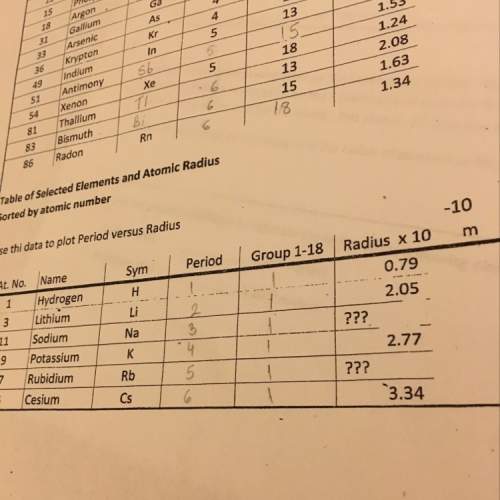
Chemistry, 08.07.2019 10:30 amberskids2
Matthew was working with different concentrations of hydrochloric acid in the lab. which of these would best describe the results matthew would see if he was using a conductivity apparatus in each of the different acid concentrations? a) the bulb would burn the same in all concentrations. b) the light bulb would burn brightest in the weakest acid. c) the light bulb would burn brightest in the strongest acid. d) the light bulb would not burn as acids do not conduct electricity.

Answers: 2


Another question on Chemistry

Chemistry, 21.06.2019 20:30
In a laboratory experiment, a fermenting aqueous solution of glucose and yeast produces carbon dioxide gas and ethanol. the solution was heated by burning natural gas in a bunsen burner to distill the ethanol that formed in the flask. during the distillation, the ethanol evaporated and then condensed in the receiving flask. the flame of the burner was kept too close to the bottom of the flask and some of the glucose decomposed into a black carbon deposit on the inside of the flask. during this experiment the following changes occurred. which of these changes involved a physical change and not a chemical change? check all that apply. 1-condensation of ethanol 2-evaporation of ethanol 3- formation of carbon dioxide gas from glucose burning of natural gas 4-formation of ethanol from glucose by yeast 5-formation of a carbon deposit inside the flask
Answers: 2

Chemistry, 22.06.2019 08:00
Me i dont know what to do! the table compares the number of electrons in two unknown neutral atoms. comparison of electrons atom number of electrons a 10 d 11 use this information to determine the number of valence electrons in the atoms. which of the following correctly compares the stability of the two atoms? both are unreactive. both are highly reactive. a is unreactive and d is reactive. a is reactive and d is unreactive.
Answers: 1

Chemistry, 22.06.2019 20:00
In vapor-liquid equilibrium in a binary mixture, both components are generally present in both phases. how many degrees of freedom are there for such a system? the reaction between nitrogen and hydrogen to form ammonia occurs in the gas phase. how many degrees of freedom are there for this system? steam and coal react at high temperatures to form hydrogen, carbon monoxide, carbon dioxide, and methane. the following reactions have been suggested as being involved in the chemical transformation:
Answers: 3

Chemistry, 23.06.2019 01:00
What is the chemical name of the compound ti2o3? use the list of polyatomic ions and the periodic table to you answer.
Answers: 1
You know the right answer?
Matthew was working with different concentrations of hydrochloric acid in the lab. which of these wo...
Questions




Mathematics, 27.01.2021 14:00

History, 27.01.2021 14:00

Mathematics, 27.01.2021 14:00

Mathematics, 27.01.2021 14:00

Mathematics, 27.01.2021 14:00

Geography, 27.01.2021 14:00

Social Studies, 27.01.2021 14:00

Mathematics, 27.01.2021 14:00



Mathematics, 27.01.2021 14:00

Physics, 27.01.2021 14:00

Computers and Technology, 27.01.2021 14:00

English, 27.01.2021 14:00


History, 27.01.2021 14:00




